By: Keith Lockwood
Autumn is in the air and cooler water temperatures are causing most fish species to be more active as they feel the need to stock up body stores for the winter. This is wonderful news for fishing as it presents plenty of good opportunities for enjoying all that the fall has to give us in pleasant weather and beautiful fall foliage. Whether you are out on the bay chasing breaking striped bass or just sitting by a small peaceful pond with a youngster this is a wonderful time to get out and enjoy the outdoors.
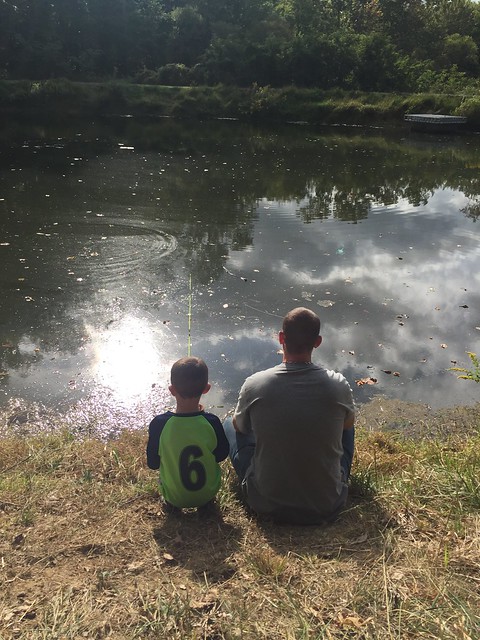
Photo by courtesy of Jayden Venable
Striped bass are being found in a variety of areas in the upper bay this week due to cool water temperatures. Breaking fish and diving sea gulls will of course catch the attention of anyone out on the water but there is a lot of other things going on, especially when it comes to looking for larger fish.
In the morning and evening hours there is shallow water light tackle action along shoreline structure such as rocks, piers, prominent points and channel edges. Most are casting topwater lures to enjoy the thrill of surface action and avoiding underwater snags. The edges of the Susquehanna Flats and areas along the bay and lower sections of the region's tidal rivers are great places to work.
Others are having good luck trolling bucktails dressed with twister tails, sassy shads or a variety of lures such Rapala type swimming lures and crankbaits at slow speeds along the edges of bay and tidal river shorelines in water depths between 6' and 12'. Trolling along deeper channel edges with a mix of umbrella rigs, tandem rigged bucktails, swim shads with and without inline weights is also a good option. Often trolling around the outside edges of breaking fish or where suspended fish can be spotted on depth finders will pay off with some legal sized fish. Live lining eels or white perch is another tactic that can pay big dividends. The deeper edges around Pooles Island and bridge piers such as those at the Key and Bay Bridges are good places to try live lining. John Hogan was fishing from the banks of the Bush River when he caught this nice sized striped bass.
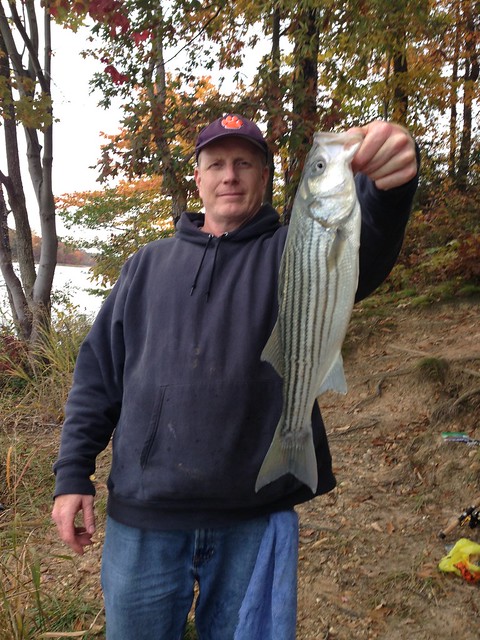
Photo by courtesy of John Hogan
Finally, jigging under or casting to breaking fish is an all time favorite light tackle activity. Many are finding that after catching and releasing small striped bass till their arms are sore that they will explore other areas for larger fish. There have been a lot of small striped bass chasing baitfish that are being swept along by strong currents, especially near the rock piles. Jigging with bucktails near bridge piers is a better option if you're after larger fish.
White perch are schooling up on oyster bars and reefs in the deeper waters of the regions tidal rivers and out in the bay. The perch seem to be on the move and it may take some exploring at various traditional bars, reefs and knolls. Bottom rigs baited with bloodworms will certainly catch perch but a jig with a dropper fly is a bit more economical and when one gets on large perch the action can be fast. Many take an inline weight, paint it and place a hook on it and then a dropper fly above so the jig has enough weight to get you down to the fish but not so large that a big perch will not grab it. Maryland anglers need to remember that legally, you can have no more than two lures or sets of hooks on one line.
In the middle bay region this week bay surface temperatures are down to 60° in most areas and bottom temperatures are running about 5° warmer; the tidal rivers are running even colder. Bait is beginning to move out of the tidal rivers now and is adding to the smorgasbord of food items available to the striped bass and remaining bluefish holding near the mouths of the rivers and out in the bay. Bay anchovies have been the most abundant forage for the sub-legal sized striped bass that are being found throughout the region. Juvenile menhaden have been accounting for the rest but now juvenile river herring and hickory shad are beginning to move out of the tidal rivers looking for warmer water.
Light tackle jigging and casting to breaking fish is always a fall delight for fishermen and one will notice that folks are now wearing duck hunting jackets, rain gear bibs and knee boots. It is getting a little too nippy to be getting wet. Metal jigs are perhaps the most popular jigs being used but soft plastic jigs will go a long way also. Diving birds often lead the way to surface mayhem but birds sitting on the water or slicks can show the way to action below the surface which can be confirmed by a good depth recorder. Channel edges where swift tidal currents push bait fish along are usually the first place to start looking. Many are noting that the novelty of catching lots of throwback striped bass soon wears off and this is when some exploring comes into play. There are larger fish out there; the strong 2011 year class has made a good showing of itself with fish in the low 20's. Also worth mentioning is the fact that some are finding some sea trout that are of legal size deep underneath the surface action in scattered areas of the bay. This little guy didn't care if the striped bass were undersized he had a ball catching them.
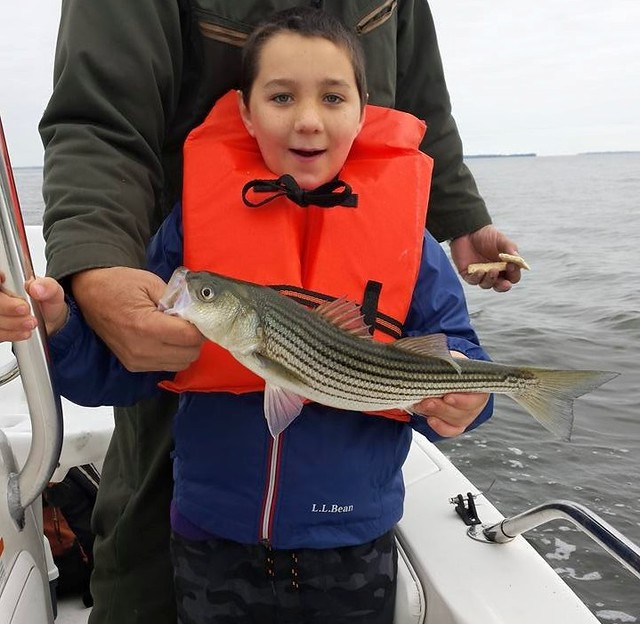
Photo by courtesy of Eddie Giese
Fishing shallower areas near prominent points during the morning and evening hours has been providing plenty of action in the shallower areas for a larger grade of striped bass and slow trolling just outside these areas can also work. Just trolling a few bucktails or swim shads flat lined off the back of the boat can often provide a few fish. Trolling umbrellas and tandem rigged bucktails with inline weights to get down close to steep channel edges and ballast stone piles (if you're fortunate to have found some and punched in the numbers).
White perch continue to be a fun option in the middle bay region and they can be found on various reefs and bars in the lower sections of the region's tidal rivers. Jigging is by far the most popular method of catching a mess of white perch but bottom rigs baited with bloodworms will certainly work also.
More and more striped bass are reported to be moving into the lower bay region this week on the eastern and western sides of the bay. Many of the striped bass on top tend to be small but larger striped bass are being reported to be holding underneath with a fair amount of sea trout, especially in the Tangier Sound area. The tidal Potomac and Patuxent Rivers offer some better striped bass action this week as does the south cut in Hooper's Island and Cedar and Cove Points. Jigging along the channel edges at these locations and others scattered throughout the region can offer good fishing as well as live lining spot for those who are able to import spot from areas farther south or who have been holding them in live pens.
White perch are schooling up on reefs and bars in the lower sections of the region's tidal rivers and sounds and provide a great fishing resource for those wishing to enjoy some fun bottom fishing and tasty eating. Jigging with a metal jig and a dropper fly is the most productive way to fish deep but a bottom rig and bloodworms will work just fine also.
Recreational crabbers have about hung up their gear for the season as water temperatures drop and chilly weather prevails. The crabs are still out there and tend to be deep as they seek warmer water. Sooks, small crabs and some light crabs are certainly a big part of the mix but there are some big and heavy crabs out there to serve as a solid punctuation mark to the finale of the 2015 season. Ted Shrimpur was out trot lining with his buddy Rich Watts yesterday and together they managed to catch almost a bushel of some massive Miles River beauties.
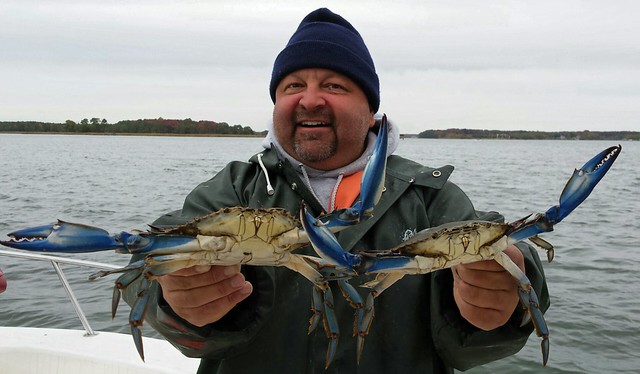
Photo by courtesy of Rich Watts
Out in Far western Maryland winter is beginning to tighten its grip on the Maryland countryside and the waters of Deep Creek Lake and regions other waters like the upper Potomac River and various trout management waters area feeling the chill. In Deep Creek Lake a mix of yellow perch, chain pickerel, northern pike and mixed sizes of smallmouth bass are biting along deep grass edges and rocky points. Water temperatures are now down into the low 50's and soon walleye will become more active.
In the upper Potomac River water flows are low and the water is being described as "gin clear". The colder water temperatures are causing the thick grass to break up and with that loss of cover crayfish are beating a hasty retreat to other cover such as rocks. Smallmouth bass fishing has been very good recently as the bass are focused on intercepting the crayfish, so tubes with jig heads and small crankbaits are good choices to imitate this favored food.
The fall trout stocking program continues this week in many of the trout management waters in all regions of the state. The stockings are being posted as they occur and these stockings should provide good trout fishing for weeks to come.
Colder water temperatures are causing grass beds and similar vegetative cover to diminish and targeting the outside edges of these areas in what are called transition areas between the shallows and deeper waters. Largemouth bass can be caught on lures that imitate crayfish or small bait fish. Spinnerbaits, small crankbaits, tubes and jigs are all good baits to try. Largemouth bass can be found of course in ponds, lakes and tidal waters throughout Maryland and there are few better times to catch them than right now. Smallmouth bass are being caught in Prettyboy and Liberty reservoirs as well as the lower Susquehanna River below the Conowingo Dam. Dominick Bolen is all smiles with this nice largemouth bass caught in a Havre de Grace pond.

Photo by courtesy of Dominick Bolen
There are great fishing opportunities for blue catfish in the tidal Potomac River this week and it is not hard to catch a bunch of them as long as you are using fresh bait. Channel catfish are active in just about every tidal river and offer some fun fishing for those wishing to take it easy in a warm and sheltered spot and watch the fall colors. Northern snakeheads are actively prowling outside grass beds as their favorite cover begins to diminish with the onset of colder water temperatures. Topwater lures will always be a favorite when fishing for snakeheads but spinnerbaits and jerkbaits work well also.
Coastal area fishing in the Ocean City area is settling down to a typical fall pattern as water temperatures dip towards the 60 degree mark. Windy conditions do not do much to help matters when trying to fish the open waters or surf but one has to be flexible and enjoy the good weather when it occurs.
Surf fishing has centered on catching small bluefish on finger mullet and fishing larger baits for the occasional striped bass or red drum. Most of the striped bass are less than 28" but soon larger fish will be migrating past Maryland's beaches from the northern states. At the inlet there are striped bass being caught on the evening tides on bucktails and swim shads. Tautog fishing at the inlet jetties, the 2nd to 4th Street bulkhead and the Route 50 Bridge is improving quickly as more and more fish move into the area. Sand fleas and green crabs are the preferred baits and cloudy water coming from the wind chopped back bay areas has been a problem on ebbing tides. Many of the tautog are undersized so the throwback ratio can be disappointing at times. There has been some striped bass and bluefish action in the back bay areas and there are still some flounder moving towards the inlet.
The fall sea bass season got off to a great start last week (the season opened on October 22). Many anglers who made the trip out to the wreck and reef sites enjoyed good fishing with plenty of limit catches on board. Tautog are being found on many of the inshore wreck and reef sites and a few flounder were also caught near these sites by those who fished for them. Elvin Philip enjoyed a great opening day and holds up two of the sea bass he caught before focusing his attention on the fish cleaning station.
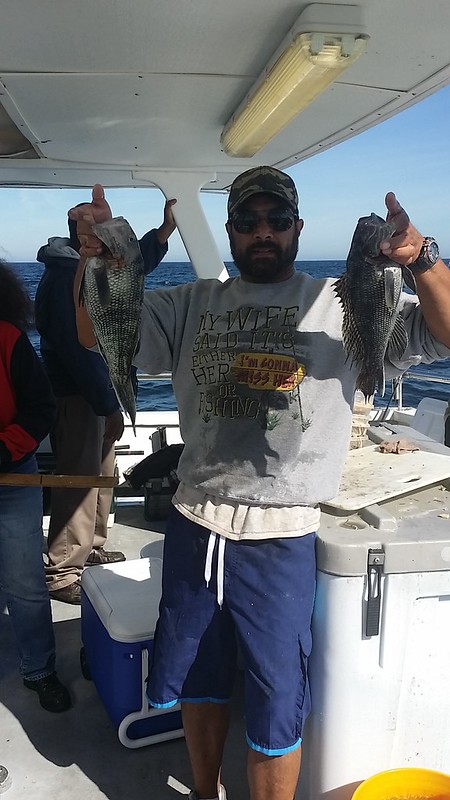
Photo by courtesy of Elvin Philip
In addition to the bottom fish, there are also plenty of bluefish in the region and they can add a substantial portion to one's catch. Farther offshore a few boats made the trip out to the canyons and some yellowfin tuna were brought back from the Norfolk Canyon.
Boom...Morgan
No comments:
Post a Comment